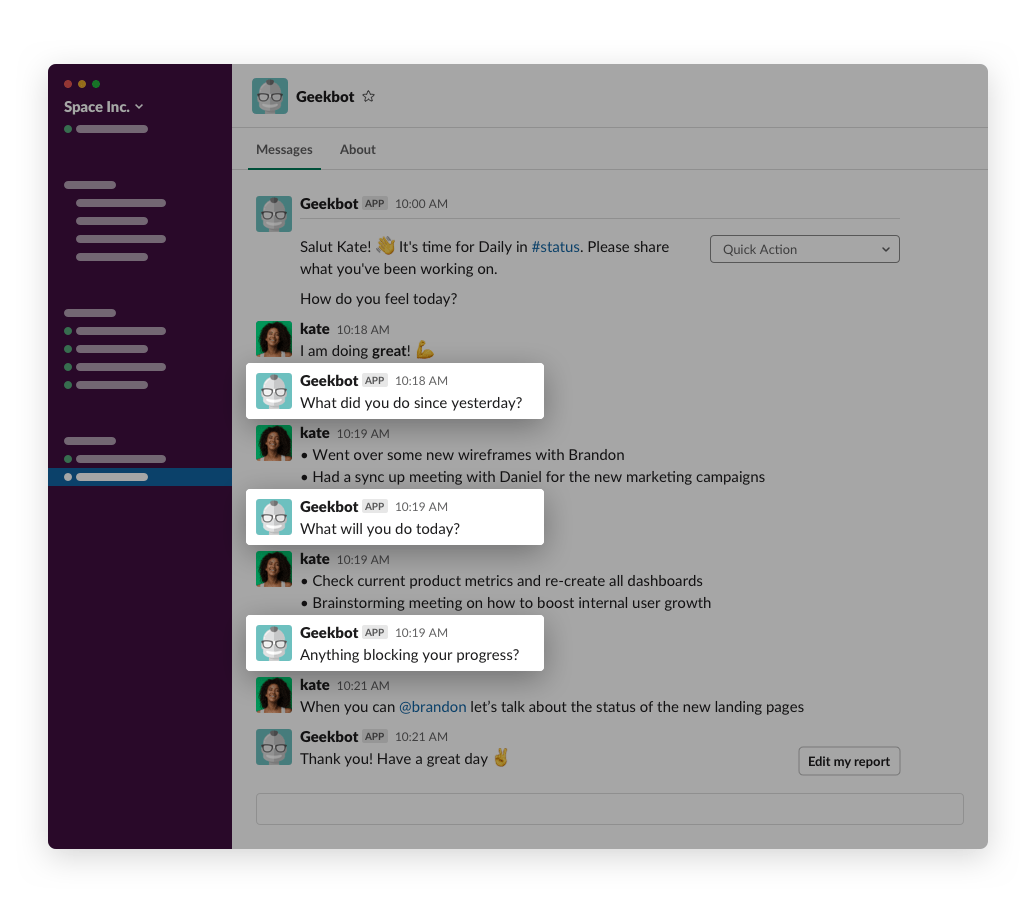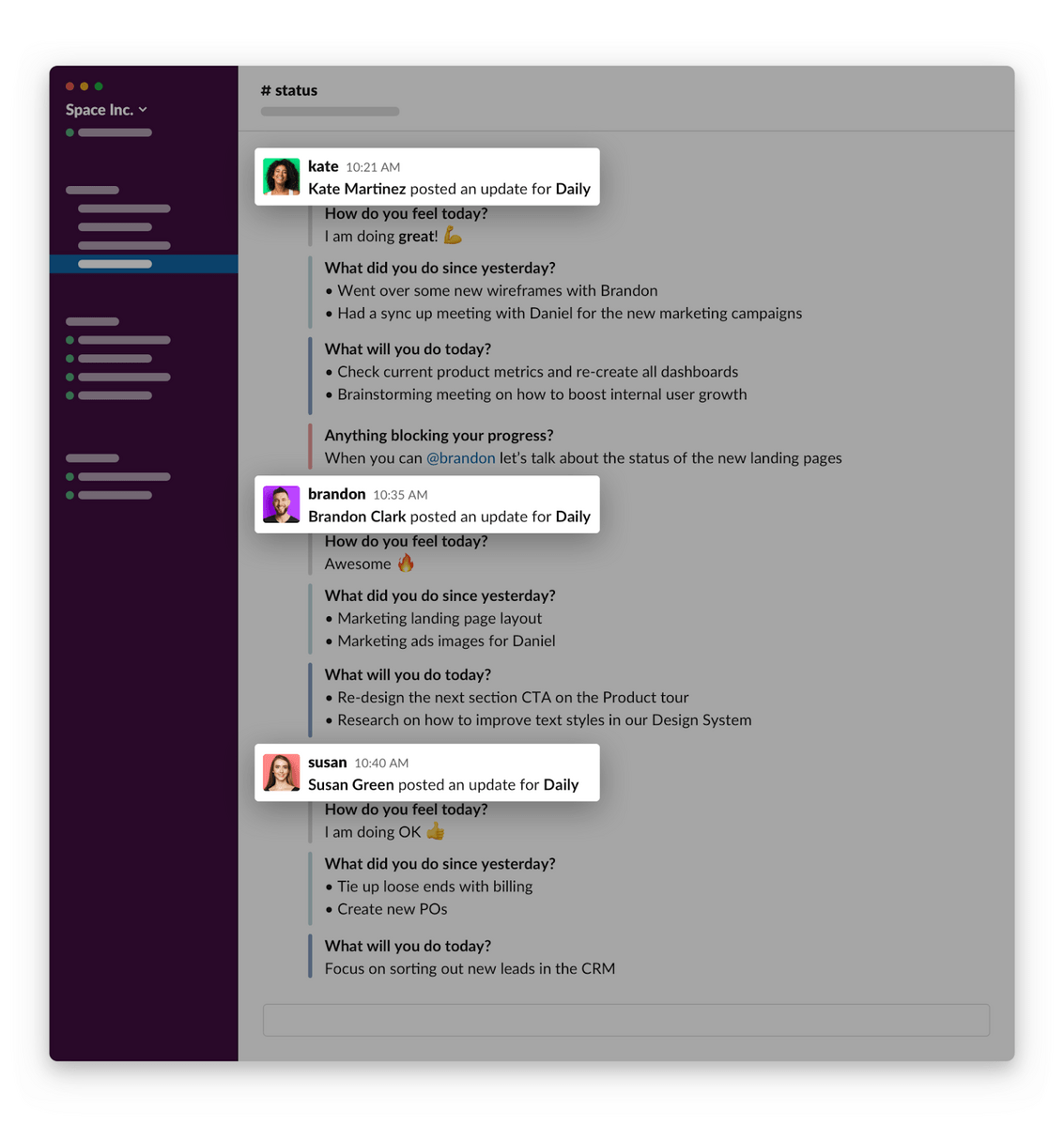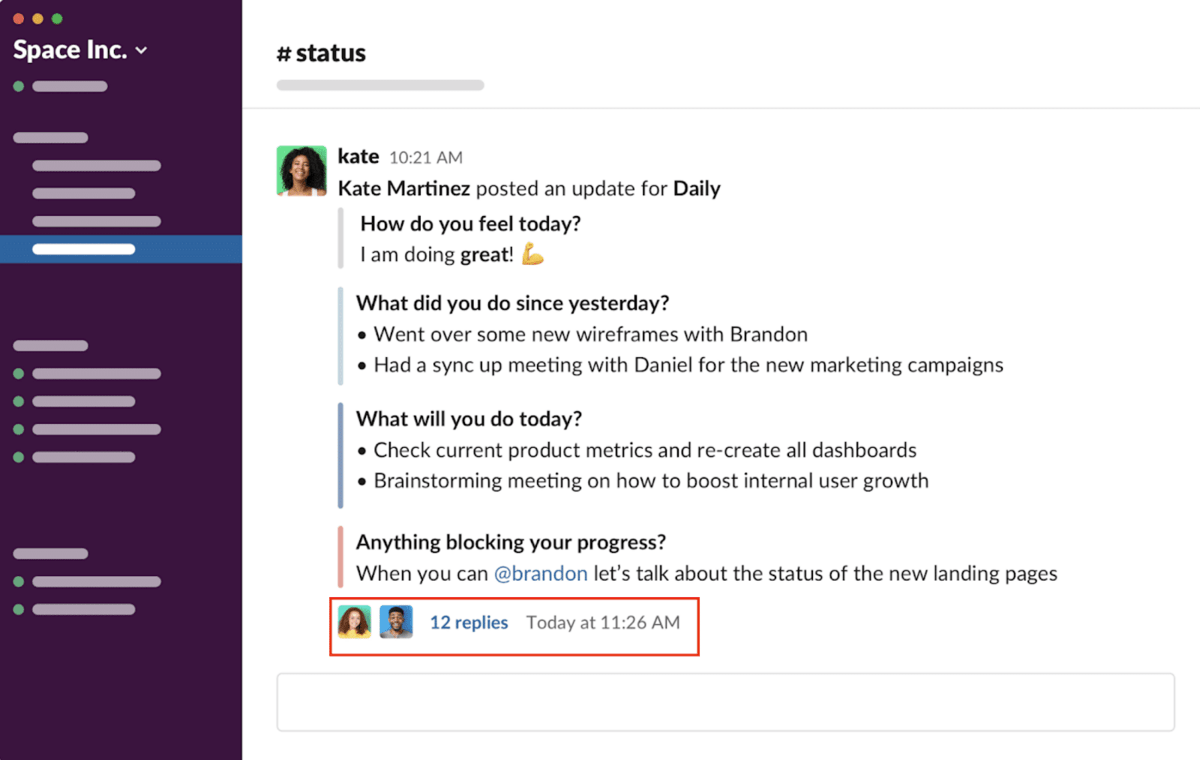In this post, we take an in-depth look at 5 Scrum Master best practices, and discuss how you can use Geekbot (our Scrum tool that integrates with Slack) to run quicker and less disruptive daily standups, retrospectives, and more.
5 Scrum Master Best Practices
- Empower Your Team and Don’t Become the Default Problem Solver. If you become the default problem solver, then team members aren’t learning as quickly and becoming better at their role.
- Take Advantage of Online Resources to Stay Up-to-Date with the Latest Best Practices. Scrum Masters should take advantage of the many podcasts, blogs, conferences, and training courses available to help them. We will list several of those resources in this section.
- Make Sure Your Scrum Ceremonies are Happening Consistently. As developers get overwhelmed or behind, oftentimes Scrum ceremonies are placed on the back burner. As a Scrum master, you want to make sure that these ceremonies are put back on the map, and are run consistently.
- Ensure That Developers See the Value in Scrum Ceremonies. A common complaint by developers against Scrum is that meetings like standups feel irrelevant and pointless. To combat this, a good Scrum master will improve the effectiveness of meetings, and thus help developers see the value.
- Don’t Overlook the Importance of Company Culture. Take the time to get to know your team members individually and build a personal connection with them. That way, they feel more comfortable coming to you with a problem, question, or suggestion.
Note: Geekbot is free for teams of 10 or fewer. Learn more and sign up here to start running asynchronous standups, retrospectives, and more inside Slack and MS Teams.
1. Empower Your Team Instead of Becoming the Default Problem Solver
Many Scrum Masters take the burden off the team by doing the jobs that their team doesn’t want to do (or isn’t necessarily good at doing), such as coming up with time estimations, breaking down user stories, and so on.
But this isn’t necessarily what a Scrum Master ought to be doing. (Or at the very least, there needs to be a healthy balance). If you become the default problem solver, then team members may become less autonomous. They aren’t learning as quickly and becoming better at their role. And even if they’re capable of solving a problem, they know they can just turn to you instead.
A good rule of thumb — if your team falls off when you go on vacation, then you’re not setting them up for success. The best Scrum Masters are ones who, instead of becoming the default problem solver, empower team members and help them feel self-reliant.
2. Take Advantage of Online Resources to Stay Up-to-Date with the Latest Best Practices
Of course, the best way to become a better Scrum Master is to learn through the job. There’s no replacement for experience — however, Scrum Masters can take advantage of various resources to increase their knowledge, and stay up-to-date with the latest practices:
Those resources include, but are not limited to…
- Podcasts: For example, the Scrum Master Toolbox Podcast releases daily episodes for Scrum Masters and Agile Coaches.
- Blogs: Here’s an article about the 20 Top Agile Blogs for Scrum Masters that you will not (easily) find on google searches.
- Events: Here’s a list of events in the Scrum community.
- Training courses: Here’s a Scrum Master training course which is created and maintained by Scrum co-creator Ken Schwaber, alongside certified Professional Scrum Trainers (PSTs).
3. Make Sure Your Scrum Ceremonies are Happening (Consistently)
While this one may sound obvious, it’s not uncommon for Scrum ceremonies to take a backseat as calendars get busier.
Sprints often start on track but then blockers build up, developers get overwhelmed or behind, and usually the first thing that gets placed on the back burner are Scrum ceremonies.
As a Scrum master, you want to make sure that these ceremonies are put back on the map and run consistently.In addition, it’s important to figure out why the ceremonies were abandoned in the first place, and correct the underlying issues.
As we discuss next, Scrum ceremonies — especially the daily standup meeting — are designed to help ease the burden, not add to it. So if these meetings were abandoned due to feeling unproductive to developers, then they likely aren’t being conducted correctly.
4. Ensure That Developers See the Value in Scrum Ceremonies
Over the years, we’ve talked to many Scrum teams about their daily standups. In our experience, these are the most common challenges that surface up:
- Standups disrupt the workday. For example, a developer is hard at work fixing a login screen error and right in the middle of coding, they have to stop what they’re doing to attend the standup. This is extremely frustrating, and it’s easy to see why developers feel like they’re wasting time that could be better spent on debugging code or crossing tasks off their to-do list.
- Standups take too long. For example, say your development team shows up to a daily standup and is prepared to give their quick answers. But then the standup gets derailed. Two developers monopolize the standup by trying to solve a blocker in real time.
- Standups are difficult to schedule. Finding meeting times that work with everyone’s calendars is challenging, especially for remote teams.
These are all valid concerns. But if Scrum ceremonies like standups feel like a disruptive waste of time to developers, then that likely means they’re not being held correctly.
How Geekbot Can Help Improve the Effectiveness of Daily Standups (and Other Scrum Ceremonies)
To solve the above challenges (and others) associated with video calls or in-person meetings, Geekbot lets teams run asynchronous Scrum ceremonies. Our tool integrates with Slack and Microsoft Teams, and it can be used for all kinds of meetings, including standups, retrospectives, and more.
Team members can complete their updates at any convenient time throughout the day, so as a Scrum Master you (1) don’t have to struggle with finding a time that works for everyone and (2) ensure that meetings are quicker and less disruptive.
How does it work?
Geekbot notifies each person via Slack that it’s time to complete their update. In the example below, team members are prompted to answer the daily standup questions, and they can do so at any convenient time throughout the day (rather than being disrupted in the middle of coding to attend a video or in-person meeting).

The team’s answers to the standup questions then get shared in a Slack channel of your choosing:

If someone needs help solving a blocker, like Kate does in the example below, then Brandon can respond just to her, creating a thread without disrupting others.

A Scheduling Plus for Remote Teams
Geekbot will automatically factor in your user’s timezone when sending out notifications that it’s time to complete a Scrum ceremony.

If you have team members across the globe, then they’ll get notifications from Geekbot when it makes sense for them based on their timezone, and not late in the night or early in the morning.
5. Don’t Overlook the Importance of Company Culture
Many Scrum Masters overlook the importance of improving company culture (and thus the satisfaction and fulfillment that team members receive from their role). To help with this, we recommend that you…
- Get to know team members individually and build a personal connection with them. You want to create a culture of transparency and open communication where everyone on your team feels comfortable coming to you with a problem, question, or suggestion. This helps your team feel valued and as an important part of a whole.
- Keep your Scrum ceremonies engaging. Scrum ceremonies are habitual, but that doesn’t mean they need to be one-note and boring. When we spoke with Heather Sills, an experienced Scrum Master and Product Owner, about what it takes to be a good Scrum Master, she talked about how she was once in a standup where the developers were asked to represent how they were currently feeling via a drawing. This is outside of the box thinking and helps keep the ceremony fresh and your team members engaged.
If you’re holding asynchronous standups that rely on text-based responses then you can add questions which help keep the standup fresh. For example, you can ask “What’s your favorite movie?” or “What’s an interesting article you read last week?” Or you can ask your team to upload a meme that best represents how they feel.
Many Geekbot users have also been fans of the “Pizza Toppings” template, where a random set of team building questions gets sent out to team members. For example:

In the above screenshot, Helen mentioned that her favorite book is “Brave New World”. If another teammate has read it in the past, they can now reach out to Helen and form a bond over a shared interest. This will make it more enjoyable to work together going forward, and improve overall team well-being.
How Geekbot Helps You Track Team Happiness
Because Geekbot is a text-based asynchronous Scrum tool, you can edit your questions to include “How are you feeling today?”

Over time, Geekbot analyzes the sentiment of the responses to this question, and then quantifies team happiness via a graph. Now by looking at your Geekbot dashboard, you can see whether or not the majority of your team is satisfied. This way if you start noticing a downward trend, you can be proactive as Scrum Master, and solve any issues that are making team members unhappy and less productive.

Note: Geekbot is free for teams of 10 or fewer. Learn more and sign up here to start running asynchronous standups, retrospectives, and more inside Slack and MS Teams.
You May Also Like…
- How We Use Geekbot to Manage a Distributed Agile Team from Slack
- 11 Daily Scrum Anti-Patterns We Commonly Hear from Users [In-Depth Look]
- 12 Best Scrum Tools for Project Management in 2021 (Jira, etc.)
- How to Run Sprint Retrospectives [Exact Process]
- 4 Alternatives to Tedious, In-Person Daily Scrum Meetings
- Overlooked Benefits of Daily Standup Meetings for Agile teams
Frequently asked questions
What Can a Scrum Master Do Better?
The Scrum master can always be working towards creating a self-reliant team. This means facilitating communication between developers, keeping sprints on track, and making sure Scrum ceremonies are being executed properly.
Specifically, a Scrum master facilitates Scrum processes to the entire team and makes sure the team is following a Scrum framework.
This is a challenging role as it can involve “fixing” what “isn’t broken.” By which we mean, a dysfunctional team may still meet their sprint goal or quickly work through the last few product backlogs.
But a good Scrum Master understands that if a team is off process it’s only a matter of time until blockers start to form or employees complain about handling most of the workload.
Because of this, a Scrum Master can always strive towards understanding how to instill a Scrum methodology, even in teams that appear to be doing fine without it.



